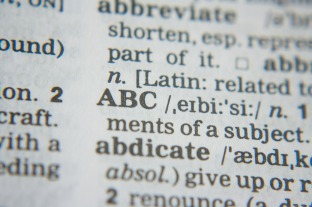
Every field has its own jargon — words, terms, and acronyms that sound like a whole special language. Publishing is no exception. What’s a newbie to do? Or a not-so-newbie who’s still learning the language? Fear not! Herewith a handy glossary of terms used in publishing and in the wider writing community. Thanks to all the 12×12’ers, Rumpus Writers, and others for suggestions!
Glossary of Publishing Terms
- advance: A payment received when a book contract is signed, in advance of publication. The advance must earn out before the author or illustrator receives another payment. (see also earn out)
- ALA: American Library Association. Holds twice-yearly conferences that offer opportunities for publishers to reach librarians and promote their upcoming releases (with lots of ARCs). Also sponsors several prizes for children’s books, the oldest of which are the Caldecott and Newbery medals.
- ARC: Advance Reader Copy. A paperback copy of a book that publishers send to book reviewers, bloggers, and bookstores to encourage advance reviews and orders. May vary slightly from final published edition. (see also F & G’s) For digital ARCs, see NetGalley, below. Not to be confused with. . .
- arc: character arc, plot arc, chapter arc, etc. This term describes the character’s journey or the rising and falling action in a scene, chapter, plot, subplot, or the book as a whole. It’s often an arc shape, but it doesn’t have to be–see the excellent post What Shape Is That Story? by Joyce Audy Zarins.
- beta reader: someone who reads a WIP, marks corrections, and makes suggestions before it is sent out on sub or posted online. Like a critique partner, but the term beta reader is a newer term with roots in online fiction and fanfiction
- blad: a flyer with a few spreads from the inside of a book, used to promote it.
- bleed: an image or design element that runs off the edge of the page and into the trim (see also trim)
-
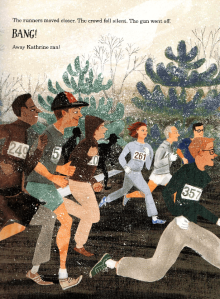
Full BLEED illustration from HER FEARLESS RUN (c) Kim Chaffee, text and (c) Ellen Rooney, illustrations -
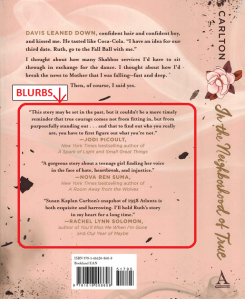
BLURBS. Click to enlarge. From IN THE NEIGHBORHOOD OF TRUE (c) 2019 by Susan Kaplan Carlton blurb: brief description of what your book is about, included in a query letter. But it can also mean an excited quote by More-Famous-Person-Than-You printed on your book cover. See the excellent explanation of the difference by agent Jessica Faust in The Definition of “Blurb.” Not to be confused with. . .
- Blurb: A Print On Demand service (see also POD)
- Book Expo of America (BEA): an annual gathering of most of the publishing world, held in New York each late May/early June. Jen Malone wrote about her experience in How Book Expo of America Is Just Like Disneyland (Sort Of).
- Bologna: The city in Italy that hosts the yearly Bologna Children’s Book Fair. (Not a deli meat served at Publisher’s Lunch)
- commercial fiction: generally describes plot-driven works that focus on action and ideas; (see also literary fiction) See agent Sarah LaPolla’s guest post Literary vs. Commercial Fiction on Kathy Temean’s Writing and Illustrating blog.
- comp titles: comparable titles or comparison titles; books mentioned in a query that are similar to, and appeal to the same audience as, the one you are submitting. Agent Paula Munier explains it well in Comparable Titles 101 on the Career Authors blog. Author Cindy Williams Schrauben has a good series about PB comps at ReFeReMo. (see also mentor text, query)
- cover letter: a brief letter that accompanies a manuscript that has been requested by an editor or agent. (see also query letter) Harold Underdown compares Query & Cover Letters here.
- CP: critique partner: a person who reads and provides constructive feedback on WIPs. Also critique group. (see also beta reader)
- dummy: a mock-up of what is on each page in a book; especially useful for developing picture books and showing where text and images will fall on a 2-page spread (see also 2-page spread)
- earn out: When a book has earned royalties for an author or illustrator that are equal to the advance paid to the author or illustrator, the book has earned out its advance. (see also advance)
- embossing: stamping paper (usually a cover) to raise part of it up so it is no longer flat
- epilogue: a part of a story that follows the end; often describes what the characters went on to do after the conclusion of the story (see also prologue)
- F & G: Folded and Gathered book pages that are not yet bound. Provided for checking before the book is printed and bound for distribution. Sometimes pronounced “Effin’ G!” because they’re Great to see! F & G’s are sometimes bound as a paperback and used like an ARC. (see also ARC)
- filter words: words in a manuscript that unnecessarily “filter” the action through the eyes of the character, creating distance between character and reader. See Susan Dennard’s post Filter Words at Pub(lishing) Crawl. See also links in Alison Potoma’s post How to Edit a First Draft.
-
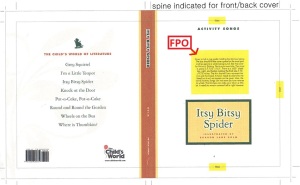
Click to enlarge. FPO for cover image of ITSY BITSY SPIDER (c) Sharon Lane Holm FPO: For Position Only. Refers to an image or text description used as a placeholder on a preliminary page proof.
- full: an entire manuscript requested by an agent or editor in response to a query. (see also partial) A request for a full is a Very Big Deal, so make absolutely sure your book is finished, polished, and ready to be seen by professionals before sending a query!
- galley: pre-electronics-age term for printed text that has not yet been divided into pages. Survives in NetGalley. (see NetGalley)
-
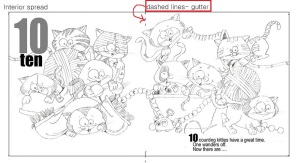
GUTTER. Click to enlarge. 2-page layout showing gutter from COUNTING KITTIES TEN TO ONE (c) Sharon Lane Holm gutter: the space where two pages meet in the middle of a picture book spread. (See also 2-page spread)
- herewith: used to indicate an attachment; usually used (or used to be used) in letters or transmittals; for example, “herewith are galleys of your latest book; please return your corrections by….”
- high concept: a book with a premise that explains itself; the movie “Snakes on a Plane” is often used as an example. Rebecca Gomez does a good job explaining this for picture books in What Does High Concept Mean, Anyway?
- Horn Book: Journal of children’s literature established in 1924. Posts book reviews, articles, news, etc.
- indie: independent, meaning not affiliated with a publisher (in the case of a self-published author) or chain (in the case of a bookstore)
- informational fiction: nonfiction with elements of fiction, for example the Magic School Bus series or the Magic Tree House series. See author Melissa Stewart’s excellent explanation.
-
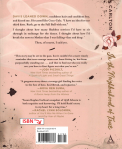
ISBN. Click to enlarge. IN THE NEIGHBORHOOD OF TRUE (c) Susan Carlton Kaplan ISBN: International Standard Book Number. A 13-digit (formerly10-digit) number that identifies a specific title in a specific format. Find out more here.
-
-
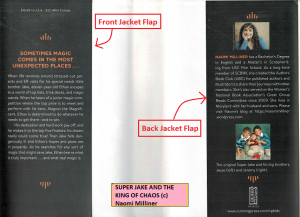
JACKETFLAPS. Click to enlarge. SUPER JAKE AND THE KING OF CHAOS by Naomi Milliner JFC: Jacket Flap Copy. The text on the paper flaps that hold the book cover in place. The front flap usually describes the book in an enticing way, while the back flap holds brief biographies of the writer and, if appropriate, illustrator. The back of the cover may have blurbs. (see blurb)
- Kirkus: Site that posts objective book reviews in all genres. A good review is good, a starred review is even better!
- literary fiction: notoriously difficult to define, but generally refers to character-driven works that focus on themes and language rather than plot; (see also commercial) See agent Sarah LaPolla’s guest post Literary vs. Commercial Fiction on Kathy Temean’s Writing and Illustrating blog.
-
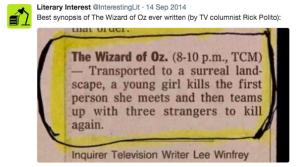
This LOGLINE is accurate, but it misrepresents the movie. logline: a one-sentence summary of a book, movie, or other work meant to entice an agent, editor, or reader. See Writing a Killer Logline by GraemeShimmin.
- MC: Main Character
- mentor text: a well-written book that is similar to an author’s work in progress (WIP), which the author studies as an example of a successful book in the same genre. Not necessarily the same as a comp title (see above). ReFoReMo (see below) is a fantastic resource for finding mentor texts.
- MG: abbreviation for Middle Grade, usually ages 7-12
- MS or MSS: abbreviation for manuscript and manuscripts
- #MSWL: Manuscript Wish List, a place, space, and Twitter event where editors and agents post what they are looking for
- NaNoWriMo: National Novel Writing Month, which happens in November of each year. Thousands of people worldwide each try to complete 50,000 words on a new novel in thirty days.
- NaPiBoWriWe: National Picture Book Writing Week, a challenge in which participants commit to writing seven PB manuscripts in as many days, hosted in May of each year by Paula Yoo.
- NetGalley: A site where publishers and authors make books available for review prior to publication.
- NF: Non Fiction
- non-compete: a clause in a contract that prevents the author from publishing a substantially similar (competing) work with a different publisher. See Clause By Clause: Non-Compete by agent Kelly Van Sant on the Pub Crawl blog.
- on sub: see sub
- option: a clause in a publishing contract that gives the publisher rights, or rights of refusal, to an author’s future work. See Negotiating Options in Publishing Deals by Susan Spann over at Writers in the Storm.
- OSD: On Sale Date (probably? Reader, if you can confirm, please say so in the comments! Thanks.)
- #OwnVoices: hashtag used to identify and recommend books about diverse characters written by authors from the same group as that character, started by author Corinne Duyvis
- P&L: Profit and Loss statement; a spreadsheet that publishers use to predict whether sales of a book will make a profit after covering production costs
- partial: a sample of a longer work, for example the first four chapters of a novel, requested by an agent or editor in response to a query (see also full, query)
- PB: abbreviation for Picture Book, usually ages 3-6
- PB Bio: picture book biography
- #PitMad: event on Twitter where writers pitch their manuscripts and agents request queries by “liking” the tweets. TIP: If you are not an agent or editor, DO NOT “like” a tweet with this hashtag!
- POD: Print On Demand. A general term for books that are printed as the buyer orders them through services such as Lulu, IngramSpark, Blurb, etc. Mostly applies to indie authors. (see also indie)
- POV: Point Of View. See Dare to Change Your Point of View for an in-depth explanation by Laura Fineberg Cooper.
- print run: the number of books printed at a time. Mostly applies to traditionally-published books. (see also POD)
- prologue: a part of a story that precedes the beginning, often to provide backstory that affects the characters; whether readers pay attention to prologues is a matter of debate. (see also epilogue)
- Publisher’s Lunch: A newsletter about and for the publishing industry.
- Publisher’s Marketplace, a post of daily deals and acquisitions by publishers.
- PW: Publisher’s Weekly. Another important source of news about the publishing industry. Children’s Bookshelf is an especially helpful page.
- query: a brief letter meant to entice an agent or editor into requesting a partial or full manuscript. (see also cover letter) Harold Underdown compares Query & Cover Letters here.
- SCBWI: Society of Children Book Writers and Illustrators.
- SLJ: School Library Journal. Professional journal for children’s and teen’s librarians. Posts reviews of books from PB to YA.
-
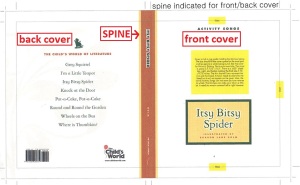
SPINE. Click to enlarge. From cover mockup of ITSY BITSY SPIDER (c) Sharon Lane Holm spine: the part of a printed book cover between the front and back, that spans the binding of the book
- spread, also called 2-page spread: two pages facing each other in a book or magazine. See also gutter, above.
- spot gloss: a special shiny finish on part of a page
- StoryStorm: A challenge in which participants commit to generating 30 story ideas in 30 days. Hosted each January by Tara Lazar. (Formerly held in November as PiBoIdMo, Picture Book Idea Month.)
- sub, also on sub, out on sub: short for “out on submission.” Describes the time period after a manuscript has been submitted to publishers and before a response is received from those publishers. It can go on for months. Authors sometimes lose their fingernails, sleep, etc.
- recto: the right-hand page in a 2-page spread (see also 2-page spread, verso)
- ReFoReMo: Reading For Research Month; A challenge in which participants read 100+ picture books as mentor texts in one month. Hosted each March by Carrie Charley Brown and Kirsti Call.
- representation: what an agent offers; the agent represents an author or illustrator’s work to publishers, and takes a percentage of the advances and royalties as payment.
- reviews: published opinions about Your Book, on blogs, Amazon, Goodreads, etc. Good reviews on professional sites such as The Horn Book, Kirkus, and SLJ are a Very Big Deal, because they tell readers your book is worth reading, and therefore tell booksellers and librarians that your book is worth shelf space.
-
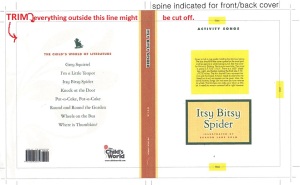
TRIM. Click to enlarge. ITSY BITSY SPIDER (c) Sharon Lane Holm trim: the edges of the page that get cut off when the F & G pages are trimmed before binding (see also bleed, F & G)
- TK: to come. Often appears on a preliminary page proof to indicate where an illustration will go. Or it may refer to a whole illustrator who has not yet been selected!
- 12 x 12: Yearlong challenge in which participants write and revise twelve picture books in twelve months. Hosted each year by Julie Hedlund.
- verso: the left-hand page in a 2-page spread (see also 2-page spread, recto)
- YA: abbreviation for Young Adult, generally ages 14-up.
- YALLFest and YALLWest: Young Adult Literature readers’ convention held in Charleston, South Carolina and Santa Monica, California. A great place to pick up ARCs!
- WFH: Work For Hire. A contract arrangement in which a writer or artist is hired to create a work for a fee; the copyright of that work then belongs to the hiring organization.
- WIP: Work In Progress. (How many do YOU have going at once?)
Related Post: The Alphabet Soup of Publishing by Jen Malone
Special Thanks to:
Sharon Lane Holm for generously sending files of proof stages and dummies from her books, and letting me mark them up with labels! Also Susan Kaplan Carlton, Kim Chaffee, Ellen Rooney, and Naomi Milliner for use of imagery and cover of their books. Featured Image “Definition” by Gerd Altmann from Pixabay

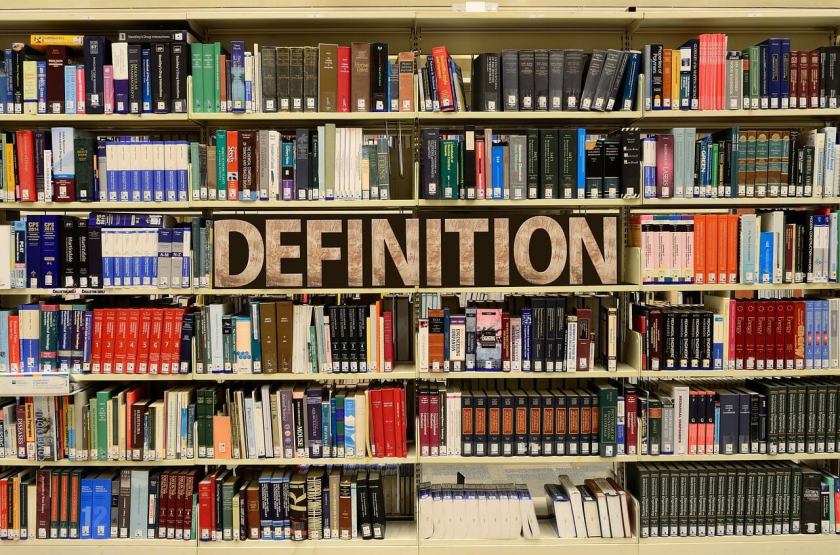
Great blog I enjooyed reading
LikeLike
Super list, and such universal terms! Not sure if these two words fit the category but I am frequently asked the meaning/difference between prologue and epilogue.
LikeLiked by 1 person
I added prologue and epilogue, thanks for the suggestions!
LikeLiked by 2 people
Oh, I see you have MS already. sorry! 😊
LikeLiked by 1 person
Publisher’s Marketplace is in there already, too. I will add the others soon, thanks for your suggestions, Meeg!
LikeLiked by 1 person
You’re welcome, it’s a great resource! And my suggestion on Publishers Marketplace was about the definition as “a post of daily deals,” when the subscription service is actually an important research tool used by many in kidlit. Just to make the definition more complete and helpful to folks. 😊
LikeLiked by 1 person
This is so great! Thank you for compiling! Terms to consider adding: #ownvoices (important!), PB Bio (picture book biography, can be longer, older age range than fiction PB), NF (nonfiction), Informational fiction (see Melissa Stewart’s blog for description), MS (manuscript). Also Publishers Marketplace is a subscription website used by many in the industry where you can look up deals, who edited what books, who reps who, etc. (Some people subscribe for just a month at a time while researching/querying.) And maybe add the abbreviation CP with crit partner, as lots of folks just use that. Again, fabulous resource you’re putting together! Will help many. 💕
LikeLiked by 1 person
Added! Thanks for the suggestions.
LikeLiked by 1 person